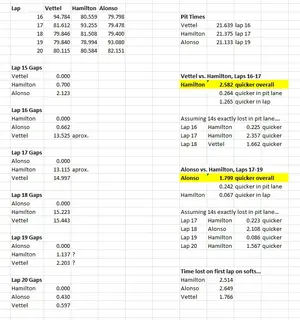Welcome to the Tyre Analysis for the 2012 Canadian Grand Prix. The Circuit Gilles Villeneuve often hosts a spectacle of on-track action, but this time it was all about the tyres and the strategy. The track temperature was fluctuating wildly, in and out of the tyres optimum performance zone, whist the degradation levels meant a one or two stop race was a viable option.
And for newcomers, the spreadsheet works by collecting data from the raw lap times, and it can work out how much fuel has been burned, and it also takes into account tyre age and condition at the start of the stint. Unusual lap times due to close proximity to other cars or errors are filtered out.
For the second race in a row the Super-Soft will be the option, and the Soft the Prime tyre. The lack of high-speed made it an easy decision for Pirelli, as the tyres only have to survive small lateral loads.
The option tyre first, as that it what the majority of drivers ran their first stint on, and at first glance it seems that the Red Bull’s and McLaren’s had particularly bad tyre wear. From the graph it seems clear that they could not have made the one-stop work. Alonso and Ferrari on the other hand had no such issues, and were looking good whilst the rest of the leading pack flocked in for new rubber. Ferrari were clearly reacting, but I think they could have easily done another six or seven laps on those tyres, whilst they would be in a bad position come the end of the race the newer rubber would prove crucial.
An honourable mention to some of the teams lower down the order, who managed to keep the option tyres alive for a very long time, Maldonado was on his (new) super-soft tyres from lap 29 through to the end. Räikkönen and Perez also took advantage of the rubbered-in track to post long stints.
I’ve left a few more curves in for the Prime tyre to show how the pattern was similar all down the field, except for Jenson Button. His nightmare in a bubble car saw his tyres begin to fade three times quicker than the drivers he is usually racing against. The car was clearly set-up badly, possibly due to the lack of Friday running through various issues.
Alonso’s long run on the Soft tyre was very impressive, but it seems that when he put them on they were already second-hand! I don’t know exactly how long they were used for, presumably only a few laps, but a few laps were the difference between his F2012 crossing the line 1st and 5th.
It is also worth noting how it took several laps for the tyre to reach its peak performance, something usually reached after 3 or 4 laps.
Here is a more detailed and specific look at the top three’s tyre experiences, with the dots been the raw data.
If there is something else you want me to have a look at just say, and I will post the graphs.
Put together you can see how the Soft tyre behaved like a perfect option, initially faster, before descending into the pit of despair that is degradation.
Unfortunately there is no data from last year due to the rain, so no comparisons can be made with the old compounds.
In two weeks time, at Valencia, the Soft and Medium tyre will be used, and hopefully there will be sufficient difference in the compounds to mix it up or do anything at all that makes the racing less dull.
Thanks for reading.
tooncheese,
jez101,
sushifiesta

